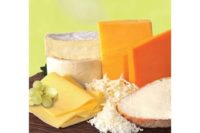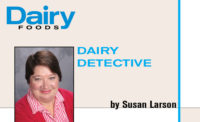U.S. cheesemakers meet the demand for industrial cheese

U. S. cheese production is booming, with almost a quarter of the world’s cheese coming from inside our borders. That equates to more than 5 million metric tons (11 billion pounds) produced in the United States in 2013 alone.
With this growth in overall production has come increased usage of cheese as an ingredient for industrial users. In 2012, the total cheese volume used in industrial production in the United States was approximately 2.6 billion pounds, or 25% of all cheese consumed in the United States.
As U.S. production continues to grow, key markets around the globe are demanding more cheese — especially cheese used as an ingredient. Overall, sales of U.S. cheese to international customers have skyrocketed more than 575% since the turn of the century.
In the last five years, U.S. producers have made significant supplier share gains in nations such as Egypt, Japan and Saudi Arabia, and they are ready to keep growing.
“With the largest cow’s milk supply in the world, an abundance of land and investments in research and technology, the U.S. cheese industry is capable of continued growth to meet customer demand in these developing areas,” said Vikki Nicholson, senior vice president of global marketing for the U.S. Dairy Export Council.
Cheese, versatile cheese
More than 600 varieties of cheese are available from skilled U.S. cheesemakers. Today, mozzarella and Cheddar cheeses lead the industrial segment, accounting for more than 60% of cheese used in the U.S. food processing channel. Cheese powders and enzyme-modified cheeses are another important category within industrial cheese ingredients.
Cheese powders may contain one or more natural cheeses and are used as a primary flavor ingredient in prepared foods. When concentrated flavor is needed, enzyme-modified cheeses are a good option for standardizing natural cheese flavor. U.S. cheese suppliers can create hundreds of dry cheeses and blends with different flavors, colors, functional properties and price points.
While flavor is the primary driver for incorporating cheese as an ingredient, cheese also may be added to foods to increase viscosity, add mouth-feel, improve color or bind other added ingredients.
“Advanced technologies have enabled cheese manufacturers to tailor cheese with specific functional properties, such as controlled browning, restricted melt and sharper flavor profiles,” Nicholson said. “These innovations help put the United States at an advantage when aiming to meet global consumer demand in prepared food applications.”
Cheese provides calcium, protein
Beyond its functional properties, cheese can provide health and nutritional benefits to global diets. Cheese is an important source of dietary calcium for children and adults. Most cheeses act as a good to excellent source of calcium to meet daily calcium guidelines in the U.S. and many other countries.
Cheese also is defined as a high-quality protein, meaning it contains the essential amino acids in amounts proportional to the body’s need for them. It’s an easily-digestible food, allowing sufficient amounts of these amino acids to reach the body’s cells. Early research also indicates that milkfat found in cheese increases high-density lipoprotein (HDL) cholesterol, which is associated with reduced risk of cardiovascular disease.
Recent years have seen the use of cheese as an ingredient in many applications within the United States. Ready meals were the most popular form in the United States, with cheese appearing in more than 1,000 new product applications in 2014, up 12% from 2013. Snacks were the second-most popular application to use cheese as an ingredient, showing up in 313 new product applications last year.
Recipes for snacks, entrees
To help highlight the functional and health benefits of cheese as an ingredient and to meet consumer demand, USDEC has developed many prototypes to help spur U.S. dairy industry innovation. Here are two examples:
- Poutine-inspired Cheese Dippers feature Juustoleipa-style cheese ready for dipping in a rich mushroom sauce. With a combination of high-quality U.S. dairy ingredients, this snack contributes 30% Daily Value of calcium and 15 grams of protein. See http://tinyurl.com/olcumx9.
- Pepper Jack Mac & Cheese trims the fat without sacrificing flavor or performance by using reduced-fat cheese. It targets time-crunched consumers who seek in-home meal solutions such as quick preparation foods and healthier frozen entrées. See http://tinyurl.com/ofel3nz.
When it comes down to it, the U.S. cheese industry has important growth opportunities at home and abroad — opportunities it is poised to seize as the world’s largest cheese producer and exporter.
“The U.S. cheese industry is capable of even more growth to meet customer demand,” Nicholson said. “Customers have come to rely on its consistent supply of high-quality cheeses. As we look ahead, the U.S. cheese industry is ready to meet future innovation needs and is well recognized for its advancements in cheese-making research and technology.”
Visit ThinkUSAdairy.org for more information on using cheese as an ingredient in a variety of applications.
Looking for a reprint of this article?
From high-res PDFs to custom plaques, order your copy today!






